Habitat Directive: Annex II, IV. MED Conservation Status: “Unfavorable-bad” (2013-2018).
IUCN Red List: Endangered” at global level, with decreasing trend. At the Mediterranean level, a conservation status assessment of this species is not yet available due to the scarcity of data. In the latest report of the Marine Turtle Specialist Group, dated 2020, about 2,800 nests are estimated each year in the Mediterranean, distributed mainly between Turkey, Cyprus and Syria.
Sighting possibilities
It does not nest in Italy. Juvenile individuals are sometimes sighted, mainly along the Apulian and Calabrian coasts. The species, as it is a tropical species, has a slight tolerance to low temperature compared to Caretta caretta..
How to recognise it at sea
Size: in the Mediterranean, adults can reach a carapace length of 120 cm and a weight of between 100 and 200 kg. The carapace has four pairs of non-overlapping rib shields (hawksbills), which are olive-brown with yellow or marbled stripes and spots, while the plastron (the underside) is light-coloured, between white and yellow. Younger specimens have a more uniform carapace colour with limbs edged in white/yellow. The tapered head is proportionally smaller than Caretta caretta and has only a pair of pre-frontal plates. As in other sea turtle species, sex can only be distinguished in adults, with the male having a more developed tail and longer forelimb nails.
Biological notes
Like most sea turtles, they make foremost migrations, even thousands of kilometers, frequenting a large number of locations and habitats throughout their lives. After an initial phase in which juveniles opportunistically feed on organisms they encounter in the open sea, green turtles become predominantly herbivorous, feeding on plants and seaweed they find in low-lying, well-lit coastal environments. Upon reaching sexual maturity, males and females head for the breeding grounds. After mating, males return to coastal feeding sites, mainly located along the North African coast, while females head to the beaches for nesting. At the end of the breeding season, females also migrate back to the feeding areas with high site fidelity.
In the Mediterranean, the breeding season runs roughly from May to September, with peak activity between June and July.
Curiosities
- It is the only sea turtle primary herbivore.





